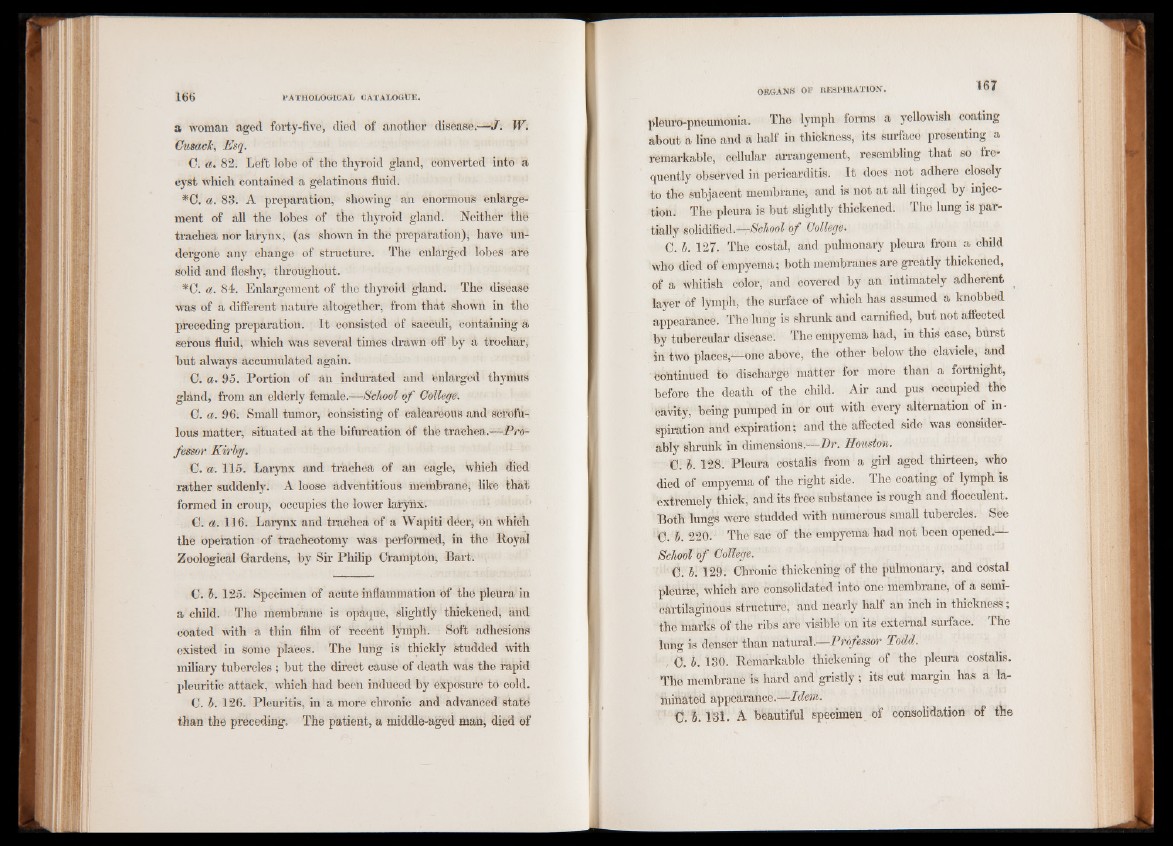
a woman aged forty-five, died of another disease.'—J. W.
Cusack, Esq.
C. a. 82. Left lobe of the thyroid gland, converted into a
eyst which contained a gelatinous fluid.
*C. a. 83. A preparation, showing an enormous enlargement
of all the lobes of the thyroid gland. Neither th'e
trachea nor larynx, (as shown in the preparation); hate undergone
any change of structure. The enlarged lobes are
solid and fleshy, throughout.
*0. a. 84. Enlargement of the thyroid gland. The disease
was of a different nature altogether; from that shown in the
preceding preparation. It consisted of sacculi, containing a
serous fluid, which was Several times drawn off by a troohar,
but always accumulated again.
0. a. 95. Portion of an indurated and enlarged thyittUS
gland, from an elderly female.—School of College.
0. a. 96. Small tumor, consisting of calcareous and scrofulous
matter, situated at the bifurcation Of the trachea.—Professor
Kirby.
C. a. 115. Larynx and trachea of an eagle; ivhieh died
rather suddenly. A loose adventitious membrane; like that
formed in croup, occupies the lower laryffx'.
<3. a. 116. Larynx and trachea of a Wapiti deer, On which
the operation of tracheotomy was performed, in the Royal
Zoological Gardens, by Sir Philip Cramptoh, Bart; ,
C. 1. 125. Specimen of acute inflammation of the pleura in
a child. The membrane is opaque, slightly thickened, and
coated with a thin film 'of recent lymph. Soft adhesions
existed in some places. The luhg is thickly studded with
miliary tubercles; but the direct cause of death was the rapid
pleuritic attack, which had been induced by exposure to cold.
C. b. 126. Pleuritis, in a more chronic and advanced state
than the preceding. The patient, a middle-aged mail, died of
ORGANS o r RESPIRATION. 167
pleuro-pneumonia. The lymph forms a yellowish coating
about a line and a half in thickness, its surface presenting a
remarkable, cellular arrangement, resembling that so frequently
observed in pericarditis. It does not adhere closely
to the subjacent membrane, and is not at all tinged by injection.
The pleura is but slightly thickened. The lung is partially
solidified.—School of College.
C. b. 127. The costal, and pulmonary pleura from a child
who died of empyema; both membranes are greatly thickened,
of a whitish color, and covered by an intimately adherent
layer of lymph, the surface of which has assumed a knobbed
appearance. The lung is shrunk and carnified, but not affected
by tubercular disease. The empyema had, in this case, burst
in two places,-—one above, the other below the clavicle, and
Continued to discharge matter for more than a fortnight,
before the death of the child. Air and pus occupied the
caVity, being pumped in or out with every alternation of inspiration
and expiration; and the affected side was considerably
Shrunk in dimensions.—Dr. Houston.
0. b. 128. Pleura costalis from a girl aged thirteen, who
died of empyema of the right side. The coating of lymph is
extremely thick, and its free substance is rough and flocculent.
Both lungs were studded with numerous small tubercles. See
0. b. 220. The sac of the empyema had not been opened.—
School of College.
0 . b. 129. Chronic thickening of the pulmonary, and costal
pleUrse, which are consolidated into one membrane, of a semi-
cartilaginous structure, and nearly half an inch in thickness;
the marks of the ribs are visible on its external surface. The
lung is denser than natural.:—Professor Todd.
, 0. b. 130. Remarkable thickening of the pleura costalis.
The membrane is hard and gristly; its cut margin has a laminated
appearance.—Idem.
C. j. 131. A beautiful specimen of consolidation of the